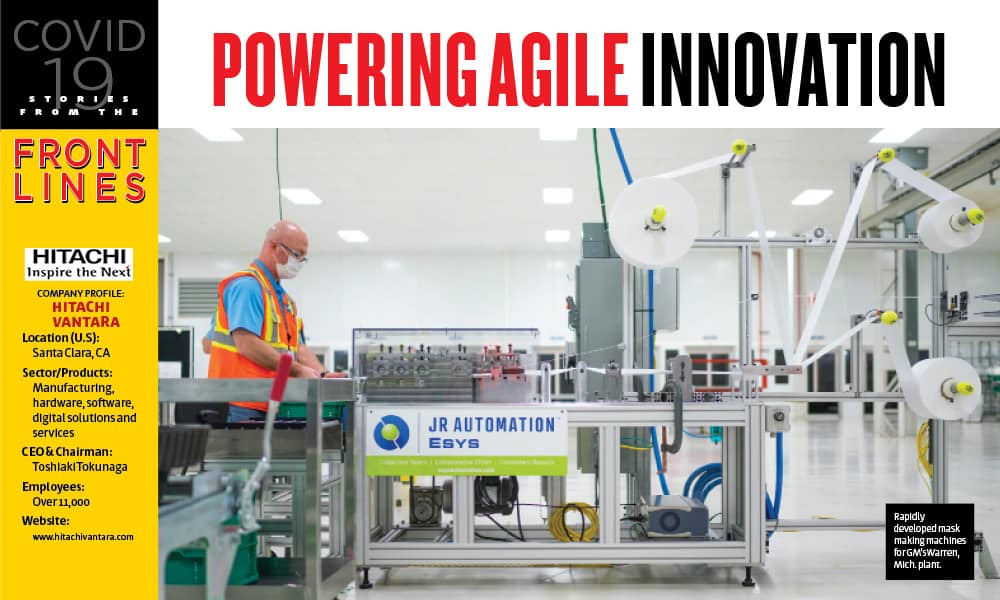
Radical technologies and innovative approaches are helping manufacturers meet the new normal.
With more than one hundred years of history, Hitachi was already responding as a manufacturer during the global flu pandemic of the early 1910s and 20s. While manufacturing technologies have greatly advanced since that time, the need for agility and innovation is still front and center for the industry.
Now, in the face of COVID-19, Hitachi Vantara is aiding manufacturers to become agile and manage supply-chain shocks. And it’s also innovating new ideas to help plants keep workers safe and continue essential manufacturing as the industry emerges from the crisis.
For example, when General Motors learned of the shortage of personal protective equipment (PPE) for healthcare workers in the U.S., it immediately made plans to convert a Warren, Mich. plant that previously made automotive transmissions into a face mask manufacturing site. Swapping out its existing production lines to produce different products required more than changing a few pieces of simple equipment.
And the changeover needed to happen fast. In light of the crisis, GM wanted equipment in place and running in less than a week. It also needed the entire mask assembly line to be able to produce 50,000 masks a day, with the potential to make even more.
Knowing it would need entirely new manufacturing equipment, the automaker contacted Esys Automation, in nearby Holland, Mich. Esys makes turnkey automation robotic systems for the automotive industry. GM already had a design layout of a mask-making machine from their plant in China, but this needed to be translated into English and vendors for special equipment needed to be engaged for customization.
GM knew that turnkey was an operative word here, as was custom. Esys Automation’s parent company JR Automation, part of Hitachi which typically delivers automation and robotics integration for manufacturers, immediately stepped in and designed and built the custom machinery for mask assembly based on GM’s requirements.
GM’s initial call came on Saturday, March 21. That same afternoon, teams at JR Automation and Esys designed equipment based on parts available in their supply chain.
The joint teams were in such swift motion that engineers were able to release designs for build shortly after they had been designed. GM’s initial call came on Saturday, March 21. That same afternoon, teams at JR Automation and Esys designed equipment based on parts available in their supply chain. One part did have to be airlifted from China, but even that happened quickly. Esys Automation delivered its first part to GM six days after that first call and by that afternoon the plant produced its first of many, many masks.
This is agility in action, combining humans and machines and data, as well as providing a collaborative eco-system for pandemic response and beyond.
Hitachi has also been busy developing technologies to help improve safe working environments at its own and other manufacturing plants. When the pandemic struck and new social distancing norms were put-in place, engineers got together to figure out how they could help build worker trust and ensure safety on the shop-floor. What came to mind immediately were Hitachi’s 3D LiDAR (light detection and ranging) solutions. LiDAR devices aren’t cameras, rather they’re a remote sensing method that uses pulsed lasers to measure distances and ranges without capturing personal information. Some plants have already been using 3D LiDAR combined with machine learning and artificial intelligence tools for collision detection, to optimize forklift paths and avoid accidents, for example. By detecting anomalous behavior, the technology can also alert for slip-and-falls, security breaches, unsafe behavior, intrusion into restricted areas, or unsafe distances between people and machines or robots.
When the pandemic struck and new social distancing norms were put-inplace, engineers got together to figure out how they could ensure shop floor safety.
Combining the 3D LiDAR technology with Lumada Video Insight and thermal imaging cameras for the new challenge, manufacturing plants were able to deploy an automated solution that allowed continuous monitoring of worker body temperature on the shop-floor. The lasers return information by way of myriad points of light that are then used to make up digital, 3D representations of the target. The point cloud cannot identify workers, but it can alert workers and managers when, for example, employees stand too close to one another on the line or fail to thoroughly wash their hands. Managers can then space workers differently, or find ways to prevent the bottlenecks that happen when people move toward an exit at quitting time or congregate in a break.
Machine Learning in Action
Meanwhile in Italy, transport manufacturer Hitachi Rail Spa. has deployed Hitachi Vantara’s Lumada software and systems across its facilities to help overcome scheduling challenges and better monitor and scale production efficiency during its post-COVID ramp-up. This is being achieved by the systems’ ability to intuitively operationalize plant floor learnings using Machine Learning techniques that enrich core repositories to help improve quality and drive resilient supply chains. As Hitachi Rail’s plants work through the phases of workers returning to production, these systems are helping the company coordinate production schedules, enhance efficiencies, manage just-in-time manufacturing, and reduce quality challenges. Other manufacturers grappling with similar post-pandemic start-up issues have also approached Hitachi to benefit from its internal experience of integrating systems-of-records and islands of automation.
Ready for the Next Normal
Looking forward, manufacturers will reopen. And when they do, officials will need to go beyond providing masks to ensure employees are safe from infection. COVID-19 has changed the rules of safety in ways that are only now being developed. But some things are clear. Employees on the plant floor, machines and data, will all need to be orchestrated for better value and prepare the manufacturing industry for the Next Normal. COVID-19 has exposed some of the shortcomings of current systems and spotlights the need to move to Manufacturing 4.0 at an accelerated pace. Manufacturers still need access to vital information, harness the power of good old-fashioned collaboration, and continually pursue new technology innovations. M